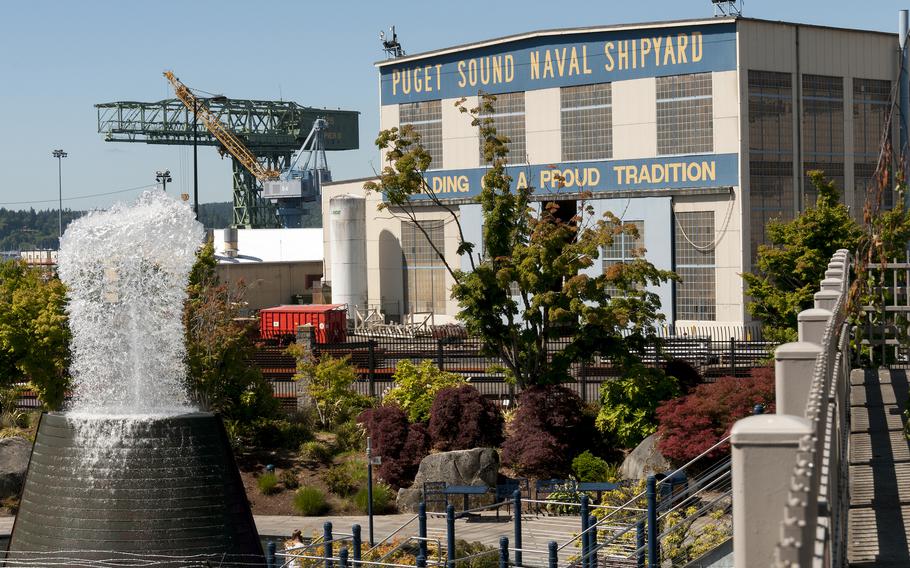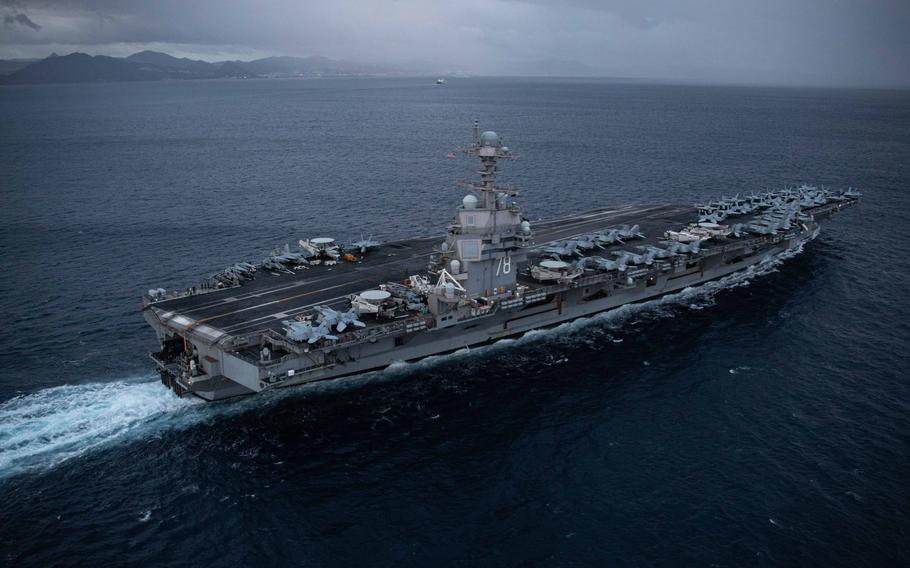
The Puget Sound Naval Shipyard and Intermediate Maintenance Facility in Bremerton, Wash. The Navy said Thursday, April 17, 2024, that its four shipyards would get a “C+” if graded on their ability to repair ships damaged in a sustained military conflict. (U.S. Navy)
Outdated public shipyards would get a low grade for the ability to repair warships damaged in a major conflict, a top Navy official said Wednesday.
Nickolas Guertin, the assistant secretary of the Navy for research, development, and acquisition, told the House Armed Services Committee’s subpanel on seapower and projection forces that the 20-year, $21 billion project to modernize and expand the four Navy shipyards in Hawaii, Washington, Maine and Virginia would increase repair capacity.
Rep. Donald Norcross, D-N.J., asked for a “letter grade” of current ability in the event of war.
“To be perfectly frank, I am not sure I would give us a great grade,” Guertin said.
Norcross pressed for a more concise answer.
“It’s back to elementary school,” Norcross said. “C, D, F — where would you put us?”
“C+,” Guertin said.
The exchange about shipyards was part of a hearing marked by bipartisan discontent over the direction of the proposed $257.6 billion Navy and Marine Corps budget for fiscal 2025.
A plan to delay ship and submarine building to spend more on addressing overall supply chain and contractor workforce needs has drawn some rebukes from Republican and Democratic lawmakers during recent hearings in the House and Senate.
The tone of Wednesday’s hearing was set in the opening remarks by Rep. Trent Kelly, R-Miss., the subpanel’s chairman, who chastised the plan approved by President Joe Biden.
“This president’s budget request sends the wrong signal, seeking to divest 19 ships, including 10 that haven’t reached their expected service life, and purchasing only six,” he said. “A diminished Navy emboldens Beijing and undermines America’s position as the global maritime leader.”
Guertin’s opening remarks were framed by action in the Red Sea from last weekend when the destroyers USS Carney and USS Arleigh Burke reportedly destroyed 81 drones and missiles fired by Houthi rebels in Yemen at U.S. Navy and commercial ships.
“The Department of Navy remains focused on the pacing challenge of managing strategic competition with the People’s Republic of China, Russia’s illegal war of invasion of Ukraine, Houthi strikes of the Red Sea, and Iranian aggression toward our allies,” he said.
Guertin said the Navy’s budget priorities “builds and sustains the right mix of capabilities.”
But Republicans and Democrats took turns expressing objections. No one endorsed the spending plan.
Lawmakers also criticized the cut of Virginia-class submarine purchases from two to one, a delay of procuring a fifth Ford-class aircraft carrier from 2028 to 2030 and de-icing capabilities on the V-22 Osprey tilt-rotor transport, the stability of procurement of amphibious assault ships that carry Marine units, and across-the-board delays in shipbuilding of new carriers, submarines, frigates and other ships.

The USS Gerald R. Ford transits the Strait of Gibraltor on Jan. 5, 2024. Some in Congress are critical of Navy plans to delay procurement of a fifth Ford-class carrier until 2030. (U.S. Navy )
Rep. Mark Alford, R-Mo., said he understood the forces buffeting the Navy and other Pentagon budgets due to congressionally imposed budget constraints.
“The [Defense Department] is faced with tough choices and is robbing Peter to pay Paul, as they attempt to modernize, maintain readiness, and improve quality of life on a 1% defense budget increase,” he said.
Alford asked Vice Adm. James Pitts, deputy chief of naval operations, about warfighting requirements and capabilities and whether cutting the Navy in the short term was the right approach.
“Are 293 total ships enough to meet all the demands of the Navy at a time when we must deter great powers and keep sea lanes open while under attacks from terrorists such as the Houthis in the Red Sea?” he asked.
Pitts pointed to the Navy’s official Battle Force Ship Assessment and Requirements Report.
“We need 381 ships,” Pitts said. “So the answer to the question is, no, we don’t have enough at 293.”
Rep. Mike Gallagher, R-Wis., called on the Congress to push for an outside commission to examine the Navy’s long-range plans. The commission has already been authorized but has yet to be compiled.
“There’s a reason we do commissions from time to time — it’s when, quite frankly, Congress is exasperated,” he said. “We’ve had a series of choose your own adventure 30-year shipbuilding plans, we’ve had revelations about delays, we’ve had the 45-day review, constantly changing numbers. It just feels like more needs to be done to map out the future of the Navy.”
Gallagher pointed to the Constellation-class frigates being built at a Wisconsin shipyard by an American unit of Italian shipbuilder Fincantieri S.p.A. The 2020 contract was awarded for what was touted as a variation of a European-designed frigate already in service with Italy and France
Originally slated to be delivered in 2026, a Navy report earlier this month put the delay in delivering the lead ship in the class at up to 36 months.
“The Constellation design shared about 85% commonality with the original Italian frame design,” Gallagher said. “Indeed, that was part of the reason that Fincantieri won the award. The idea was to leverage proven design. But the alterations have brought that commonality down to under 15%. Can you just explain to us how something like that happens and what can be done to fix it?”
Guertin said the Constellation-class is planned to be a “real workhorse” in the future and that changes in power, internal design, and other aspects were necessary.
“We had to look at that through the lens of what it was going to be — a U.S. Navy fighting ship,” he said.
When Guertin termed the alterations “minimal,” Gallagher was skeptical.
“A minimal amount of change is an over 70% change, from the Navy’s perspective?” the congressman asked.
Guertin said the alterations were to “the needs of the United States Navy.”
Gallagher broke off the verbal engagement but expressed dissatisfaction with Guertin’s answer.
“OK, this is obviously going to be an issue we’re going to have to continue to tackle,” he said.
Kelly ended the hearing by suggesting that Congress wants to adjust the Navy budget when it comes time to start amending and voting on the fiscal 2025 National Defense Authorization Act.
“I think we have the greatest shipbuilders and repairs and maintainers in the world, but we have to send them the right signal all the time,” Kelly said. “We have to give them predictable schedules of both repair and building. We can’t send them mixed signals. And we can’t tell them to pause or put on the brakes or take a strategic pause.”